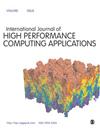Unprecedented cloud resolution in a GPU-enabled full-physics atmospheric climate simulation on OLCF’s summit supercomputer
IF 2.5
3区 计算机科学
Q2 COMPUTER SCIENCE, HARDWARE & ARCHITECTURE
International Journal of High Performance Computing Applications
Pub Date : 2021-07-16
DOI:10.1177/10943420211027539
引用次数: 13
Abstract
Clouds represent a key uncertainty in future climate projection. While explicit cloud resolution remains beyond our computational grasp for global climate, we can incorporate important cloud effects through a computational middle ground called the Multi-scale Modeling Framework (MMF), also known as Super Parameterization. This algorithmic approach embeds high-resolution Cloud Resolving Models (CRMs) to represent moist convective processes within each grid column in a Global Climate Model (GCM). The MMF code requires no parallel data transfers and provides a self-contained target for acceleration. This study investigates the performance of the Energy Exascale Earth System Model-MMF (E3SM-MMF) code on the OLCF Summit supercomputer at an unprecedented scale of simulation. Hundreds of kernels in the roughly 10K lines of code in the E3SM-MMF CRM were ported to GPUs with OpenACC directives. A high-resolution benchmark using 4600 nodes on Summit demonstrates the computational capability of the GPU-enabled E3SM-MMF code in a full physics climate simulation.OLCF峰会超级计算机上GPU支持的全物理大气气候模拟中前所未有的云分辨率
云层代表了未来气候预测的一个关键不确定性。虽然明确的云分辨率仍然超出了我们对全球气候的计算能力,但我们可以通过一个称为多尺度建模框架(MMF)的计算中间地带,也被称为超级参数化,来结合重要的云效应。这种算法方法嵌入了高分辨率云解析模型(CRM),以表示全球气候模型(GCM)中每个网格列内的潮湿对流过程。MMF代码不需要并行数据传输,并提供了一个独立的加速目标。本研究以前所未有的模拟规模研究了OLCF Summit超级计算机上能量Exascale地球系统模型MMF(E3SM-MMF)代码的性能。E3SM-MMF CRM中大约10K行代码中的数百个内核通过OpenACC指令移植到GPU。Summit上使用4600个节点的高分辨率基准测试展示了GPU启用的E3SM-MMF代码在全物理气候模拟中的计算能力。
本文章由计算机程序翻译,如有差异,请以英文原文为准。
求助全文
约1分钟内获得全文
求助全文
来源期刊
CiteScore
6.10
自引率
6.50%
发文量
32
审稿时长
>12 weeks
期刊介绍:
With ever increasing pressure for health services in all countries to meet rising demands, improve their quality and efficiency, and to be more accountable; the need for rigorous research and policy analysis has never been greater. The Journal of Health Services Research & Policy presents the latest scientific research, insightful overviews and reflections on underlying issues, and innovative, thought provoking contributions from leading academics and policy-makers. It provides ideas and hope for solving dilemmas that confront all countries.

 求助内容:
求助内容: 应助结果提醒方式:
应助结果提醒方式:


